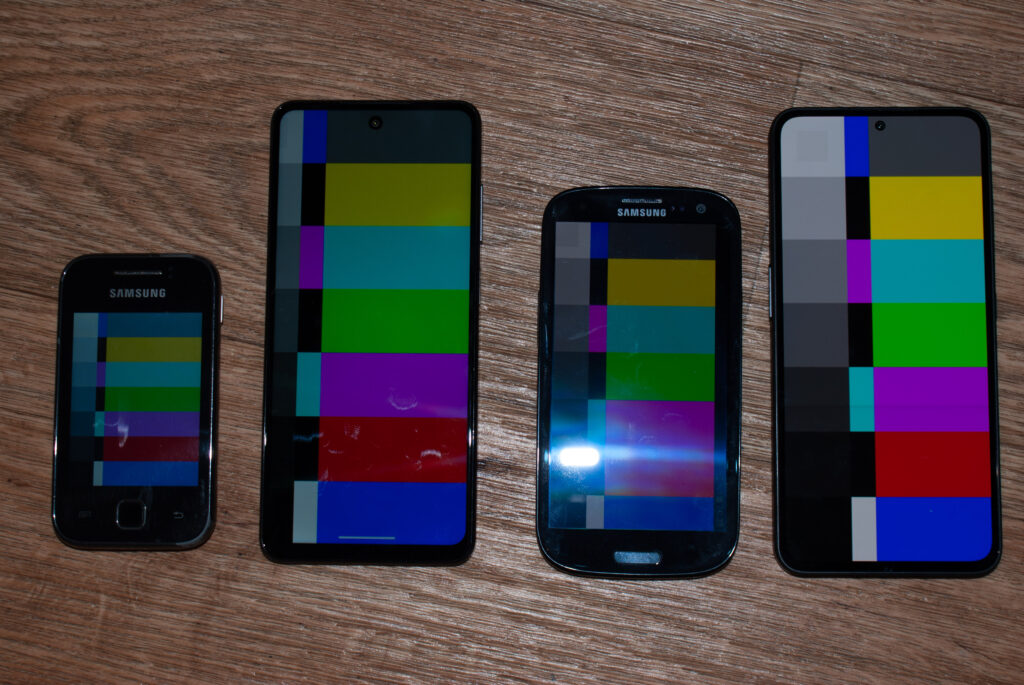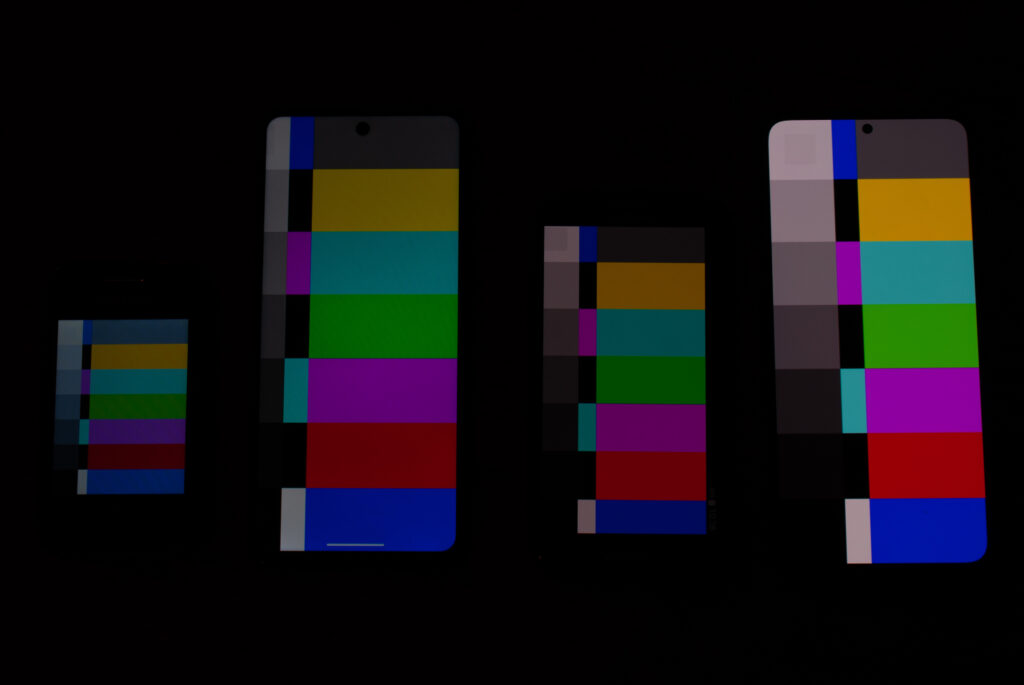Look at the specifications of any midrange or flagship smartphone today and I can guarantee with a degree of certainty that it will have an OLED screen. Look at the budget segment of the smartphone market and all but a couple of exceptions will have LCD screens. It wouldn’t be a stretch then to assume that an OLED is the premium option, which it is but would it also be correct to assume it’s the better option? Lets delve in.
OLED benefits
An OLED (or Organic Light Emitting Diode) screen is the newer technology that many of today’s more premium phones are equipped with. They have unmatched contrast, in part due to the design of these screens in that there is no backlight, each pixel is individually lit and can be turned off entirely to create a much darker black. They consume less power, again due to the individual LED’s being able to turn off (a big driving factor for “Dark mode”). They have excellent colour accuracy. They can have very fast response times due to the speed the LED’s can change state. OLED screens can be flexible, create the market of folding smartphones we’ve seen over the last few years.
OLED Drawbacks
The cost to produce an OLED panel is high, due to the organic compounds in the OLED’s having a short shelf life and a complex manufacturing process. Over extended use the OLED’s luminance, or ability to produce light decreases. This leads to a problem we refer to as “Burn in”. When these OLED panels display a static image for extended period of time they get dimmer, whilst the other OLED’s around it that were not left in that state keep their brightness, leading to a shadow of the image being permanently on the panel. On phones this commonly occurs on the status bar, or home screen. PWM (Pulse Width Modulation) is the method in which an OLED panel controls its brightness. An OLED is either in an on or off state, there is no in between. Therefore to appear dimmer the OLED will turn on and off hundreds of times a second to trick our brains into seeing a less bright image. Some people can perceive this flicker and it causes them headaches and eye strain in a term that’s now commonly referred to as “PWM Sensitivity”. Durability is also a concern with OLED panels, depending on the quality used they can be quite susceptible to impact damage and deterioration over time.
LCD Benefits
An LCD (or Liquid Crystal Display) is a more mature technology used in everything from digital watches and train departure boards to TV’s, computer monitors and mobile phones. It’s more complex in how it works compared to OLED with it’s RGB LED’s, but essentially there is a backlight which shines through colour filters to create an image. They are cheaper to manufacture because the manufacturing process is simpler and uses readily available materials. They are not susceptible to burn in. They do not have issues with PWM due to the fact the backlight brightness can be directly adjusted by simply lowering or increasing the voltage. LCD’s can achieve a higher peak brightness due to the backlight technology. LCD panels also generally have a very long lifespan.
LCD Drawbacks
On higher brightness settings LCD panels can draw a lot of power due to the backlight. Also due to the backlight the contrast between black and white is limited, this varies by quality of the LCD used. LCD’s can also have poor response times, again this varies by quality of panel and isn’t as prominent in modern LCD displays but essentially the light filters cannot respond fast enough to the input they receive and a “ghost” image can be displayed for a fraction of a second but enough to be perceivable.
Which is best for a smartphone then?
That was a lot of information, but its important when making a comparison to have all the facts. How do we go about comparing both of these technologies just for the application in a smartphone? We have to bring real use cases and user requirements into it. We also have to appreciate that not all LCD and OLED panels are created equal. There is a vast difference in quality between the best and worse panels for each of these technologies.
There are extreme ends of the user spectrum here for which the decision will be very easy: For a user with PWM sensitivity, or someone who needs to display static images for an extended of period of time they need a phone with an LCD screen. For a user playing high intensity games, or a professional photographer demanding colour accuracy they need an OLED screen.
A couple of niche features OLED panels can provide may also sway your decision too. If you need an always on display or want the deepest blacks when using dark mode, only an OLED can provide that.
Personally I fall into the category of LCD being a better choice for me. While I don’t get headaches or eye strain from an OLED screen I can detect the flicker, especially in my peripheral vision which can get annoying. I also keep my screen timeout set at 10 minutes, and often display text or an image for reference while I’m working on something, so not having to worry about burn in is a plus. I also appreciate the lower cost, my current personal phone (HMD Pulse) cost me just £60 new and sealed, whereas my work phone (CMF Phone 1) cost £165, and aside from the OLED and faster chipset it’s missing features that the HMD Pulse has. The cost of replacement is also a benefit to me too, it’s reassuring to know that if I break the screen I can replace it for £15 delivered whereas on some of the premium flagship phones a replacement OLED panel can be £200-300 just for the part, considering most users can’t fit a screen themselves it becomes worryingly expensive.
What should the average user do then? Assuming you don’t have any of the specific requirements I’ve mentioned above. In reality you don’t have much choice. In today’s market as I mentioned in the first paragraph budget phones get LCD panels and more expensive phones get an OLED panel. Unfortunately it seems this trend is only increasing and in some cases budget phones such as the CMF Phone 1 and Samsung A15 and A16 have now got OLED screens.
In an ideal world I’d like to see customers presented with a choice: The same phone with the only difference being a choice of an LCD or an OLED. Even more optimistically the LCD variant would be slightly cheaper too, passing on the reduced manufacturing cost. An LCD is arguably the best choice for most people, and the environment. It only takes a quick search on 2nd hand online marketplaces to see thousands of phones being sold as spares and repairs due to OLED burn in and broken panels.
How many of these phones would still be in use if they didn’t have this fault, and if when broken the screen could have been replaced cheaply? In a room of average people none of them would be able to discern or tell you the difference between a quality LCD and an OLED, it seems like the ingenious marketing departments of the smartphone companies have struck again.
Below I’ve taken two photos of four phones displaying the same image at maximum brightness.


From left to right we have a Samsung Galaxy Y (2011, TFT LCD), HMD Pulse (2024, IPS LCD), Samsung Galaxy S3 (2012, Super AMOLED), CMF Phone 1 (2024, AMOLED).
As you can see there are differences here, and in particular the older devices have lower max brightness levels. However even in the case of the 2011 Galaxy Y other than its miniscule size you can’t look at the display and say it looks awful. On the newer phones the bezels are smaller and the screens are much bigger but the difference between the two is marginal and these two aren’t even close to being equal. The Pulse has a PPI (Pixels per inch) of 265, whereas the CMF Phone 1 has 395.
What I’m getting at here is that specs on paper can look like a night and day difference but in reality the differences are barely noticeable. Buy what works for you best and don’t get sucked into marketing tactics!
Leave a Reply